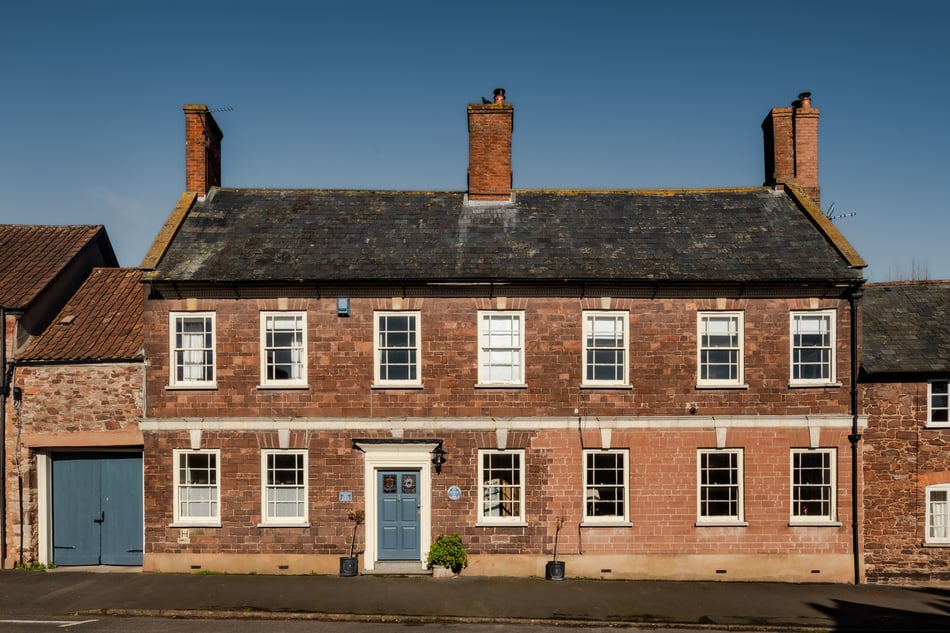
This exceptionally characterful, Grade II-listed house in Nether Stowey, Somerset, has six bedrooms across three storeys, as well as enchanting walled gardens at the rear. It has a rich history. Its owner, Thomas Poole, was a close friend of both Samuel Taylor Coleridge and William Wordsworth who frequently visited and often stayed in the house. The primary plan is exceedingly generous, stretching to over 4,800 sq ft; there is also a separate store barn, as well as an adjoining garage. Nether Stowey lies on the edge of the Quantocks and is a short drive from Bridgwater, Taunton and Glastonbury, as well as the Somerset coast.
Setting the Scene
By the end of the 18th century, the house was lived in by wealthy local farmer and tanner Thomas Poole, who is remembered as a major benefactor of Nether Stowey. Poole extended the house from its original two-bay form, adding a fashionable Georgian frontage to its simpler 17th-century core.
Particularly significant is Poole’s friendship with two of English Romanticism’s greatest poets, William Wordsworth and Samuel Taylor Coleridge, who were regular visitors to Poole House. Coleridge had moved his family to the village in 1796. During his time here he wrote some of his best-known works, from ‘Kubla Khan’ to ‘The Rime of the Ancient Mariner’, either in Poole House or its gardens.
On the front of the house, a plaque issued by Bridgwater & District Civic Society commemorates the life of Poole, as well as his friendship with Coleridge and Wordsworth. There is a local monument to Poole in Nether Stowey’s church. For more information, see the History section.
The Grand Tour
An imposing presence on Castle Street, the house has two series of six-pane sash windows with marginal glazing bars. The house itself is of squared red sandstone and has a contrasting slate roof.
Entry is through a front door in the centre of the façade, leading to a central entrance hallway. The drawing room on the right-hand side has fine solid floorboards. A trio of sash windows with their shutters and surrounding panelling spread light across the room, and period cornicing traces around the ceiling. Dove grey-coloured walls pair beautifully with a large stone original fireplace, now fitted with a log burner.
There is a sitting room on the left of the hall; it has the same floorboards underfoot and a pair of original shuttered sash windows. A beautiful fireplace sits centrally, its surround adorned with intricate relief patterns. Within is a cast-iron fire with Victorian glazed tiles on either side. A flush, built-in bookcase set in one of the alcoves provides plenty of space for a personal library.
A door opens from the sitting room to the kitchen, which has plenty of neat cabinetry and an Aga set into a former fireplace. Light is drawn in through two aspects, including a window above a deep butler’s sink and a glazed door to the garden. Grey-painted beams span overhead, recalling the house’s early history. There is room for a large dining table centrally; if desired, a more formal set-up could be organised in the adjoining sitting room.
Beyond the entrance hall is a second corridor that connects to the rear reception spaces, passing a bright bathroom and conveniently large utility space en route. The first room, the library, is beautifully lit and has French doors that open fully to the garden beyond. It is, as its name suggests, a delightful spot to sit and read. An adaptable studio space, currently used as an events room, lies beyond.
A central staircase ascends from the entrance hallway to the first floor. Here, Thomas Poole’s famous book room remains in situ, with its embracing barrelled ceiling; here, Coleridge often worked at his writing. With additional bookshelves, the space would make a wonderful working-from-home spot.
The rest of the first floor is dedicated to four good-sized bedrooms. At the front, the principal suite is remarkably generous and has an en suite bathroom and shower. It is also exceptionally bright, care of three sash windows with shutters and romantic seats below. There are two further en suite bedrooms on this level.
A second staircase ascends to the top floor, where there are two further bedrooms set atmospherically beneath the eaves. These share a bathroom and there is a useful laundry room on this level.
The Great Outdoors
The walled gardens to the house are beautiful and have been lovingly tended to over the years. Mature trees and plants include a willow tree with a wild flower garden beneath, a passionfruit flower vine, a productive fig tree, clematis and roses. One part of the garden was previously used as a small paddock; it has since been integrated into the rest of the plan. A mature conifer hedge creates a good amount of privacy. Another part of the garden has direct access from the house and has a paved rose-hung area for shady respite on the warmest of days.
There is a generous storage barn at the rear of the garden, which adjoins a garage with space for several cars.
Out and About
Nether Stowey is a large village in the foothills of the Quantocks which was designated as Britain’s first Area of Outstanding Natural Beauty. It provides plenty of scope for walking, hiking, riding, and cycling; the Bridgwater and Taunton Canal provides a scenic route for leisurely walks, fishing, and boating. Exmoor National Park lies just beyond the Quantocks and offers even greater scope for exploring nature. Poole House is also a short drive away from the West Somerset Coast, with its rugged beaches and coastal walks.
The village is known for its connection to Samuel Taylor Coleridge; his house in Nether Stowey is now owned by the National Trust and is open to visitors. It is also the start of the Coleridge Way, a 51-mile walk that the writer is believed to have taken great inspiration from. The village is also the setting of a ruined Norman castle and a Victorian town clock. There are useful day-to-day amenities in the village, including a very active community library, originally built by Tom Poole as a school; a post office and local shops, as well as two pubs: The Ancient Mariner and The George Hotel. There is also a doctor’s surgery, a veterinary surgery, and a lively church, St Mary’s.
Nearby Bridgwater offers a comprehensive range of services, including several supermarkets like Morrisons and Sainsbury’s, a library, and a variety of schools. There’s also the Engine Room, a community-run media centre that hosts workshops and events, a museum, and the annual Bridgwater Carnival and the St Matthew’s Fair in September.
There are state-run primary schools in Nether Stowey and nearby Spaxton. Private options can be found in Taunton, half an hour’s drive south, where there is also a hospital.
From Taunton station, fast trains arrive in London in around one and a half hours. Services also run to Bristol in 30 minutes, or to Plymouth in around 85 minutes. Bridgwater station is even closer to home and runs services to Exeter St Davids in 32 minutes.
Council Tax Band: G
History
Thomas Poole was born in Nether Stowey and was the son of a successful tanner and farmer. A natural leader, Poole was chosen as the West Country Tanners’ delegate to express concerns to William Pitt the Younger, the prime minister at the time.
In his younger days, Poole was a radical thinker and a passionate democrat and in 1793 set up a reading club which included the works of Thomas Paine, Benjamin Franklin and Mary Wollstonecraft. When his father died, Poole made many radical changes to the house, including building a new bark house that still stands as a separate private home.
Poole met Samuel Taylor Coleridge in 1794. They shared many of the same political beliefs and struck up a friendship, of which Coleridge wrote “we were well suited for each other”. Coleridge had been living in Bristol prior to moving to Nether Stowey with his wife, Sara, and their four-month-old son, Hartley, in 1796. The two spent much time together in Poole’s book room, discussing and exchanging ideas.
Poole was exceptionally well connected; through his friendship with Coleridge he met another Romantic poet, William Wordsworth. He was also acquainted with leading British scientists Humphry Davy and Andrew Crosse, and the Wedgwood pottery brothers, Josiah and Tom. On a visit to Paris in 1802, Poole met both Napoleon and Thomas Paine.
In 1806, Poole founded a Female Friendly Society as one of his schemes to help the local poor. It offered financial aid to working women in times of sickness, childbirth, widowhood and old age. The society is still commemorated by a yearly women’s walk to celebrate his philanthropy. He also instigated a Savings Bank to encourage working people to save. Later, around 1812, Poole founded and built a free local school. Josiah Wedgwood wrote to Poole in 1814 to ask him for a “rough sketch” of the “beautiful school” he’d built as a model for one he hoped to build himself.
Of Poole, Coleridge wrote: “His house and heart were open to all alike, and the memory of the poorest was cherished as much as that of the most illustrious.”
Interested? Let’s talk
Related Listings
- Coastal Collective: five beautiful boltholes a stone’s throw from ocean sprayHomes
- Great and Small: five exceptional cottages worth dreaming aboutHomes
- Historic Heights: six distinctly noteworthy homes, Grade II*-listed and aboveHomes
- A Private View: a self-taught vintage cognoscente shares the lessons learnt during her first renovationHomes / Interiors
- A Private View: the artful home of Robin Welch, the celebrated ceramicist who broke the mouldHomes / Interiors

